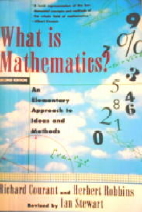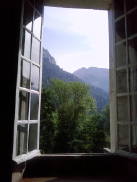My thoughts started jumping around today, trying to land on what it was that I found so fascinating about a recent article in Quanta Magazine. This is one of the statements that got me going:
…Numbers emerging from one kind of geometric world matched exactly with very different kinds of numbers from a very different kind of geometric world.
To physicists, the correspondence was interesting. To mathematicians, it was preposterous.
It was in the early nineties that the surprise first occurred, like an alert that there is a mirror symmetry between two different mathematical structures, and mathematicians have been investigating it for almost three decades now. The Quanta magazine article reports that they seem to be close to being able to explain the source of the mirroring. Kevin Hartnett, author of the Quanta article, characterizes their effort as one that could produce “a form of geometric DNA – a shared code that explains how two radically different geometric worlds could possible hold traits in common.” (I like this biologically-themed analogy)
The whole mirroring phenomenon rests largely on the development of string theory in physics, where theorists found that the strings, that they hoped were the fundamental building blocks of the universe, required 6 dimensions more than is contained in Einstein’s 4-dimensional spacetime. String theorists answered the demand by finding two ways to account for the missing six dimensions – one from symplectic geometry and the other from complex geometry. These are the two distinct arrangements of geometric ideas that mathematicians are now examining.
The nature of a symplectic geometric space is grounded in the idea of phase space, where each point actually represents the state of a system at any given time. A phase space is defined by patterns in data, not by the spatial arrangement of objects. It is a multidimensional space in which each axis corresponds to a coordinate that specifies an aspect of the physical system. When all the coordinates are represented, a point in the space corresponds to a state of the system. The nature of complex geometry, on the other hand, has its roots in algebraic geometry, where the objects of study are the graphed solutions to polynomial equations. Here the ordered pairs represent exactly positions on a grid (like those x,y pairs we learn about in high school), or complex numbers in a complex space, where those numbers are solutions to equations. The beauty of this arrangement is that the properties possessed by the geometric representation of these solutions (or the objects they produce) provide us with more about the equations they represent than we would have without these representations. But wherever they are, these solutions are rigid geometric objects. The phase space is more flexible. Hartnett tells us that:
In the late 1980s, string theorists came up with two ways to describe the missing six dimensions: one derived from symplectic geometry, the other from complex geometry. They demonstrated that either type of space was consistent with the four-dimensional world they were trying to explain. Such a pairing is called a duality: Either one works, and there’s no test you could use to distinguish between them.
Robert Dijkgraaf, Director and Leon Levy Professor at the Institute for Advanced Study tells an interesting story. Around 1990, a group of string theorists asked geometers to calculate a number related to the number of curves, of a particular degree, that could be wrapped around the kind of space or manifold that is heavily used in string theory (a Calabi-Yau space) A result from the nineteenth century established that the number of lines or degree-one curves is equal to 2,875. The number of degree-two curves is 609,250. This was computed around 1980. The number of curves of degree three had not been computed. This was the one geometers were asked to compute.
The geometers devised a complicated computer program and came back with an answer. But the string theorists suspected it was erroneous, which suggested a mistake in the code. Upon checking, the geometers confirmed there was, but how did the physicists know?
String theorists had already been working to translate this geometric problem into a physical one. In doing so, they had developed a way to calculate the number of curves of any degree all at once. It’s hard to overestimate the shock of this result in mathematical circles.
The duality appeared to run deep and mathematicians and physicists alike began to try to understand the underlying feature that would account for the mirroring phenomenon. A proposed strategy is to deconstruct a shape in the symplectic world in such a way that it can be reconstructed as a complex shape. The deconstruction can make a multidimensional simplectic manifold easier to visualize and it can also reduce one of the mirror spaces into building blocks that can be used to construct the other. This would likely lead to a better understanding of what connects them.
Again from Dijkgraaf:
Mathematics has the wonderful ability to connect different worlds. The most overlooked symbol in any equation is the humble equal sign. Mirror symmetry is a perfect example of the power of the equal sign. It is capable of connecting two different mathematical worlds. One is the realm of symplectic geometry, the branch of mathematics that underlies much of mechanics. On the other side is the realm of algebraic geometry, the world of complex numbers. Quantum physics allows ideas to flow freely from one field to the other and provides an unexpected “grand unification” of these two mathematical disciplines.
This is a remarkable story, and there are many in mathematics. I’ve always been captivated a bit by how the spatial ideas of this discipline, once charged with measuring the earth, became the abstract ideals described by Euclid, that were then stretched to accommodate spaces with non-Euclidean shapes, that include our spacetime, and were further developed to create spaces defined by patterned data of any kind – the symplectic kind. In this story, mathematicians, like experimentalists, become charged with the need to find reason for an unexpected observation. But it is an observation of the fully abstract world that mathematics built. What are these abstract worlds made of? How do they become more than we can see? I’m well aware of the lack of precision in these questions, but there is value in stopping to consider them. To what extent are these abstract spaces objective? Where are these investigations happening? There is no doubt that we have yet to understand what we realize when we find mathematics.


Recent Comments